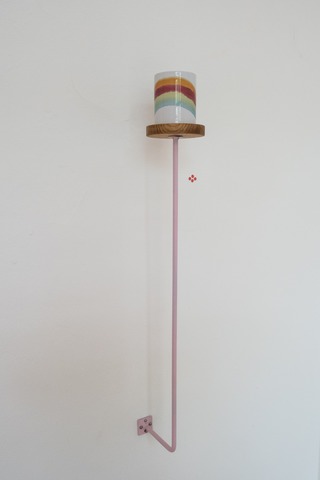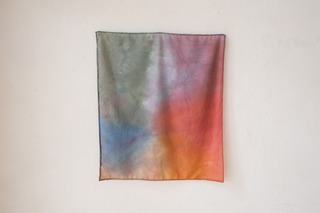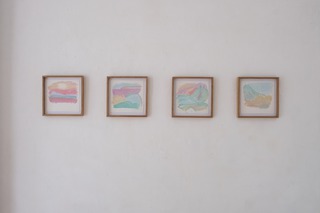Felix Jung
Farbenblind


In the second work on my personal color misperception I dealt on the one hand with the idea of the color circle - in this case with the color circle according to Itten - on the other hand with the concrete moment of the perception of color on which in usual sequence the determination/naming of the color follows. I have tried to mix the color circle of Itten. The sequence of colors and the blending of colors is defined and mathematically calculable, but due to my color vision defect I can't be sure whether I have hit this color tone which results in harmony for the normally seeing persons, because it is non-existent for me.
The idea that harmony exists through uniformly defined colors is simply not comprehensible to me. And that is why I have failed again and again in painting with this color wheel. But if I remain true to the idea of harmony and follow my own harmony, I suddenly work exclusively with colors that I cannot interpret.
In the second part of this work I devote myself to the concrete moment of the perception of color. I have made an oversized metal umbrella and painted its surface opalescent. This varnish breaks up the light into a very broad spectrum, allowing the viewer to perceive an uncountable amount of colors. At that moment, I am very close to the viewer in perception. He can tell me at that moment which colors he sees and where, but I can only believe him. The difference now is, however, that also every other observer can only believe it to him.
Since the color perception depends on the concrete point of view of the viewer and the surface is so light-sensitive that the point of view cannot be shared and the perception can only be believed.
Due to anomalous trichomasia, I cannot reliably see all colors. I can see the basic colors, but it always remains an assertion. As soon as factors of the perception change, it is no longer reliable. Incidence of light, color temperature of the light, the nature of surfaces, structures, color environment and contrasts influence the perception of colors for everyone, but for me they lead to "perception failures". Colors become ambiguous and can no longer be clearly assigned. In such cases, the brain compensates for the defective vision and creates its own unambiguity. If, for example, a banana is still green, but I cannot recognize the green tone due to some factor - e.g. because the background on which the banana lies is red, or the light does not have a neutral color temperature - my brain says: "ah banana, I have learned before, it is yellow". But actually I see something else. Only because the 'other' is not standardized it is difficult to talk about it. When I work in a color spectrum that I cannot "officially" see as a color-blind person, then the works are not gray for me, but so ambiguous that I always try to keep the relevance of the ambiguous colors as low as possible. Also so that my brain does not automatically overwrite them with its own information.
The works that I showed in the contextual exhibition - with you, without you - moved quite deliberately in a difficult for me to not at all interpretable color spectrum.




In einer weiteren Arbeit zu meiner persönlichen Farbfehlsichtigkeit beschäftigte ich mich zum einen mit der Idee des Farbkreises - in diesem Falle mit dem Farbkreis nach Itten - zum anderen mit dem konkreten Moment der Wahrnehmung von Farbe auf welchem in gewöhnlicher Abfolge die Bestimmung/Benennung der Farbe folgt. Ich habe versucht, den Farbkreis von Itten nach zumischen. Die Abfolge der Farben und die Vermengung der Farben ist zwar definiert und mathematisch errechenbar, jedoch kann ich mir auf Grund meiner Farbfehlsichtigkeit nicht sicher sein ob ich diesen Farbton getroffen hab der für die normalsehenden Personen eine Harmonie ergibt, da sie für mich nicht existent ist.
Die Idee, dass Harmonie durch einheitlich definierte Farben existiert, ist für mich schlicht nicht nachvollziehbar. Und deswegen bin ich malerisch immer wieder an diesem Farbkreis gescheitert. Wenn ich jedoch dem Harmoniegedanken treu bleibe und meiner eigenen Harmonie folge, arbeite ich plötzlich ausschließlich mit Farben, die ich nicht deuten kann.
Im zweiten Teil dieser Arbeit widme ich mich dem konkreten Moment der Wahrnehmung von Farbe. Ich habe einen übergroßen Sonnenschirm aus Blech angefertigt und dessen Oberfläche opaleszierend lackiert. Dieser Lack bricht das Licht in ein sehr breites Spektrum auf, wodurch die betrachtende Person eine unzählbare Menge an Farben wahrnehmen kann. In diesem Moment bin ich der Person in der Wahrnehmung sehr nahe. Sie kann mir in dem Moment zwar mitteilen, welche Farben er wo sieht, ich kann es ihr allerdings nur glauben. Der Unterschied jetzt ist allerdings, dass auch jede andere Person es ihr nur glauben kann.Da die Farbwahrnehmung vom konkreten Standpunkt der betrachtenden Person abhängig ist und die Oberfläche so lichtempfindlich ist, dass der Standpunkt nicht geteilt und die Wahrnehmung nur geglaubt werden kann.

Aufgrund einer Anomalen Trichomasie kann ich nicht alle Farben zuverlässig sehen. Zwar kann ich die Grundfarben sehen, aber es bleibt immer eine Behauptung. Sobald sich Faktoren der Wahrnehmung ändern ist diese nicht mehr verlässlich. Lichteinfall, Farbtemperatur des Lichtes, die Beschaffenheit von Oberflächen, Strukturen, Farbumgebung und Kontraste beeinflussen bei jedem die Wahrnehmung von Farben bei mir führen sie jedoch zu „Wahrnehmungsausfällen“. Farben werden ambig und sind nicht mehr eindeutig zuzuordnen. In solchen Fällen kompensiert das Gehirn die Fehlsichtigkeit und schafft eine eigene Eindeutigkeit. Wenn zum Beispiel eine Banane noch Grün ist, ich aber den Grünton auf Grund von irgendeinem Faktor nicht erkennen kann- z.B. weil der Untergrund auf dem die Banane liegt rot ist, oder das Licht keine neutrale Farbtemperatur hat- sagt mein Gehirn: “ah Banane, hab ich schon mal gelernt, die ist Gelb”. Aber eigentlich sehe ich etwas anderes. Nur da das ‚Andere‘ nicht genormt ist lässt sich schwer darüber reden. Wenn ich in einem Farbspektrum arbeite was ich “offiziell” als Farbenfehlsichtiger nicht sehen kann, dann sind die Arbeiten für mich nicht grau aber so vieldeutig, dass ich immer versuche die Relevanz der uneindeutigen Farben so gering wie möglich zu halten. Auch darum, damit mein Gehirn sie nicht automatisch mit einer eigenen Information überschreibt.
Die Arbeiten die ich in der kontextuellen Ausstellung - mit dir, ohne dich - zeigte bewegten sich ganz bewusst in einem für mich schwierigen bis gar nicht deutbaren Farbspektrum.









JavaScript is turned off.
Please enable JavaScript to view this site properly.